
"Vintage & hand-made hobby e-shop dedicated to the world of Subbuteo and football".
| Peter Upton's |
Subbuteo Tribute Website. |
|
Old Figures and New Manufacturers. |
|
Subbuteo Football Clones in the 21st Century. |
|
Part 3: The Table Soccer Arts and Crafts Movement. |
The 21st Century Clones page covers the major manufacturers who are working to produce modern table soccer products to rival official Subbuteo output. However, they are not the whole story. It must be pointed out that Subbuteo in the 21st Century has a fan base that has grown up with the game, and so tends to be in the 40s-60s age bracket. These older enthusiasts have three distinct areas of interest, which overlap to some degree - playing, collecting, and modelling (which includes painting).
This third area is often overlooked, but actually the roots go back to Peter Adolph, and especially the introduction of OO scale figures and accessories. In the 1970s, if you had the money, your Subbuteo set-up could rival a model railway or a war gaming table for look and accuracy. These days, the modelling side of the game is very much a niche within an already niche product, and it is rare to even be offered a scoreboard among the professional table soccer releases. Here is where the internet community comes into its own. Those who have the time and skill for crafting will often make a small surplus of items, which they will offer online - perhaps to offset their costs more than to actually make a full-time business. As with the aforementioned railways and war games, the invention of the 3D printer has been a game-changer.
This page has a slightly pretentious title. However, it does aim to highlight some of the beautiful things being produced within our hobby, and the options available for those who want a beautiful set-up, but perhaps don't have the time or the talent to realise it. This project may end up expanding over a couple of pages, especially if I give the painters more room - we'll see. An overview might be enough. Hopefully, it might also pin down some of the more obscure modern items that pass through ebay.
Part 1: Building the perfect layout.

"Vintage & hand-made hobby e-shop dedicated to the world of Subbuteo and
football".
Last year I asked if anyone was producing modern table soccer bits and bobs that they would like me to highlight on the website. Collector Francesco Manetti was brave enough to be the first to reply, so he gets the honour of kicking off the page. His products have all the love for Subbuteo that sum up what I call the crafting movement.

My initial plan was to look at the makers individually, but as I've started to add things I've decided I need to group similar products together. So I'll highlight the producers as I go, and you might see their products in various sections.
Goalkeepers for solo players.
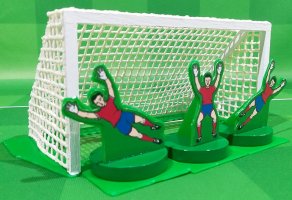
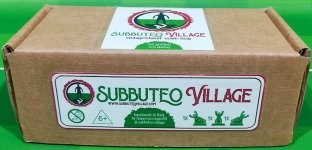
As someone who ran out of friends to play against in his late teens, these products would have been a great boon. I am aware of a large number of solo players, especially among the collecting community. Those who are perhaps intimidated by the thought of playing at a club, lack the time to attend one, or simply don't live close enough. Maybe a calming solo hobby is preferred.
To be honest, most solo players make do with holding the goalkeeper with their weaker hand, as countless children have done down the ages. However, you really need to get properly behind a long flick. The other disadvantage is that you know where you are aiming for. For me, this means I tend to save the good shots (that are heading where I aimed), and I concede the lame miss hits. Not the most satisfactory situation.
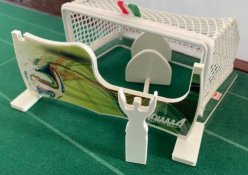
A practical product that is almost art... a Tchaaa4 training wall.
The original table soccer practise product was basically a wall in front of the goal, often with a Subbuteo goalkeeper sticking out the top, or perhaps with holes like the original Subbuteo target board. Usually, the aim of a board was to improve chipping, so that the wall covered the bottom of the goal. I find this does work with the new low bases, but chipping with a heavyweight or lightweight is an art, and walls can lead to very low scoring games.
Larger goalkeepers are a possibility for the solo player, with the bigger scale keepers from Shoot! or Striker standing in at a pinch.
However, one idea that seems to have gained traction is the three-piece solo goalkeeper set. This features a goalkeeper standing, plus keepers diving left and right. The goalkeepers represent the movements that your opponent's 'keeper would make. There don't seem to be any set rules for using these, you can place as many of them as you wish to challenge yourself in front of goal. This adds more skill to shooting, and is therefore more satisfaction than simply slotting past a static 'keeper.
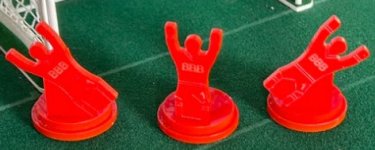
Being a practical product, these sets initially came out of the table soccer playing scene. For the most part, that meant a no-thrills approach, as these Bad Boy figures demonstrate. However, as the idea is reaching the crafters, so we are starting to see more attractive versions, such as the Subbuteovillage version shown at the top of this section..
Pitches and Playing Arenas.
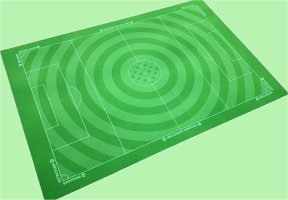
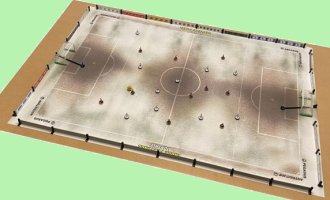
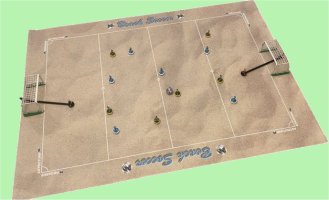
Subbuteoworld Pegasus Pitch options include swirls, snow, mud or even beach soccer.
There are lots of "professional" playing surfaces being produced (I am rather partial to Extreme Works), but if you fancy a more artisan set-up there are still plenty of options - hopefully providing both looks and performance. Even Subbuteo themselves got in on the act, with the winter pitch.
For artisan pitches, I guess the idea is to create an atmosphere, whether it be weather (snow) or an era, whether that is 1970s mud, or modern beautifully mown grass patterns. Subbuteoworld perhaps have the biggest range of these pitches, some produced with the help of Table Soccer Monthly.
For those lacking the space, there is always the popular five-a-side option. Subbuteoworld's Pegasus "game in a box" versions are clever, and their smaller Beach Soccer pitch is a lovely idea if you want to recreate a different form of football. I've seen photographs of Tom Taylor's prototype five-a-side in a wooden case, which would have been great, but was probably too expensive and time consuming to actually make...
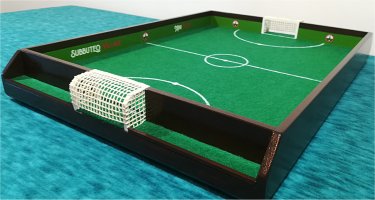
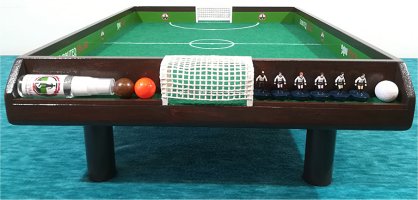
A Subbuteovillage wooden five-a-side set-up.
Full marks then to the Subbuteo Village then, who have also gone the wooden route to produce a beautiful five-a-side space that looks suitably retro. It even has optional legs, which makes me yearn to try it with some magnetic football. Shame the postage from Italy would be a killer... Also, although expensive, I can see Francesco running into a backlog of these pretty quickly. It can't be quick to make...
On a more modest DIY front, Subbuteo Online's hobby magazine mentioned using one of the classic blue office notice boards as a pitch - the felt surface on corkboard, with a light wooden frame is surprisingly effective.
Stadia.
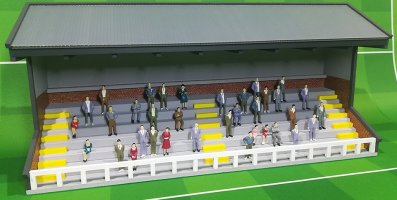
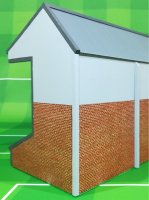
It is a fact of life that Subbuteo pitches are big. For most of us, this does give plenty of problems space-wise, which those five-a-side pitches can alleviate. However, if you are lucky enough to have lots of room, then the temptation is to recreate the box picture from the old Stadium Edition - with full four sides of stands. With any stadia project, playing will become secondary - reaching over the stands is not normally practical.
I'm returning to Subbuteovillage to start this section off, with another expensive, hand-crafted wooden construction. My little pictures don't really do this one justice, so visit his website to look at the details.
The 3D Printer Alternatives.
My general feeling about 3D printed accessories was that the majority seem to be sold via ebay or facebook sites, and were therefore not on my radar. However, things are changing, with the two UK websites shown above covering most of the main innovations in this area. I may feature more items from these sites as time goes on, but for now, here is a taster. Follow the links for more cool (or maybe crazy) ideas and accessories.
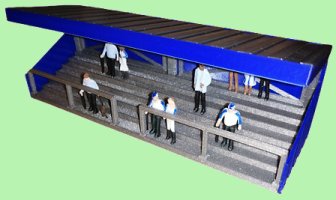
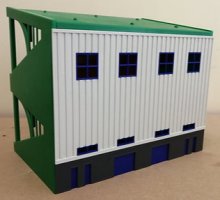
If you do want to reach the pitch, then smaller stands might be the way forward. Website The Subbuteo Mill has various 3D printer produced options, including these tiny little terraces. Or if you do have the old Subbuteo stands but want to make a more impressive looking set-up, how about fascias to add to the back of your old grandstands. Another offer from both companies is simple 3D printed seating blocks to produce the modern top-flight feel. Simply add them to your existing terraces.
It's the little things...
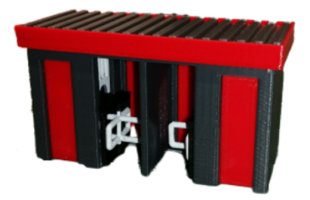
Back in the 1960s and 1970s Subbuteo produced a few famous pitch-side accessories to add to the matchday atmosphere - like the cute little TV Tower. However, times have changed, and perhaps the half-time scoreboard has you scratching your head. It has taken the modern crafters to add in the more mundane parts of the stadium, like turnstiles, fast-food sellers, or even the lavatory block. When I was a kid, I had the Lego Snack Bar (set 675 fact fans), and that did find its way into my stadium, but I didn't produce the toilets. Mind you, if Peter Adolph had thought toilets would sell, I'm sure he would have done them...
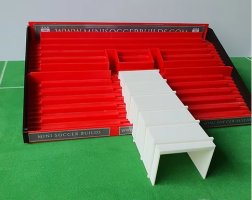
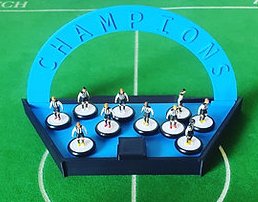
Most of the small bits of the modern match-day paraphernalia have been produced. Do you want the expanding players' tunnel? The winner's podium? The plinth the referee takes the ball from at the start of the match? You can have all those, in a range of colours.
As Subbuteo uses a very standard scale, also seen in wargaming, and train layouts, there are surprisingly good options for the DIY fan among those fields, such as paper brickwork, and sheds/outbuildings in kit form which are readily available.
It's the even smaller things....
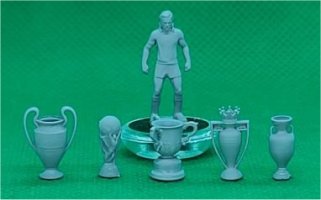
3DSoccer.ca have produced this dinky little range of Subbuteo sized trophies. If you have an old VIP set that has lost the FA Cup, here's the solution.
3D Printed People.
As I mentioned in my introduction, 3D printed figures have been a game-changer in wargaming, allowing smaller games to compete with the big established players. We're just starting to see 3D printed figures arriving in table soccer too, with a series from 3DSoccer.ca (that includes American Football). The 3D soccer box does warn that "a 3D printed figure will not be as strong as an injection moulded figure", so perhaps these figures are better for display than actual play (which is why they are on the artisan page). However, this is a new technology, and I suspect things will improve pretty quickly. In fact, the website is offering a "hard resin" option. The 3D printed women's team that I own (shown here) is impressively detailed. In fact, the detail is almost wasted at Subbuteo's tiny scale.
The figures are pleasingly also available in the UK via the Mini Soccer Builds website.
I have also seen cricket figures, and some different crowd figure options from Italy. This is an expanding field.
Part 2: Getting the Paintbrush out - Painted Players/Teams.
I've had a few galleries on this site for a while, although the small pictures on this site are not really suited to showing off the wonder of home-painting in all its glory. Here are a few of the "commercial" offerings available if you are not a dab hand with the paintbrush.
Shoot First. - Premier League Legends Range.
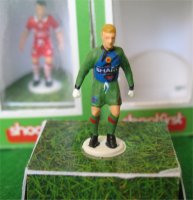
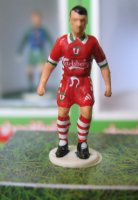
These are still mostly hand-painted with minimal decal use (chest adverts, back numbers). They were one of the first "Subbuteo art" ranges I was aware of (one of my friends at the Worthing club adored them!). The players were painted singly, as recognisable individuals, and sold in a cute little box that referenced the 1990s Subbuteo corner piece box style. Everything about them was quality. The box, the tiny card insert with grass printed around the feet. The little window. I'm not a Manchester Utd fan, so I really shouldn't have a mini Peter Schmeichel on my book shelf, but there he has sat for more than a decade. He was No.1 in the range, and deservedly so. (Robbie Fowler, also shown is No 36).
The FA's limited edition Subbuteo Women's FA Cup set was produced by Shoot First.
Players still advertised on his facebook page/etsy. Sold in a plastic dome these days.
The guy's a graphic designer in real life. Why am I not surprised?
CustomFlicks.
An old friend of this site, and a good example of quality hand-painting - without the use of stickers. These show what can be done with a steady hand and a lot of patience. Checked shirts is just showing off though!
Subbuteoworld Limited Edition hand-painted teams.
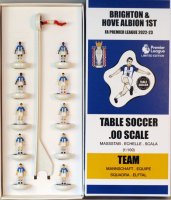
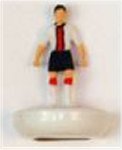
These teams don't have decals or chest adverts. They are just really solid, attractive hand-painted teams for those who like to keep their favourite sides up-to-date. The boxes are really well done, and they have an attractive price point (around the £20. mark).
Part 3: Using decals and stickers.
When I was a child, decals only came with plastic kits from the likes of Airfix or Esci. However, modern printers have allowed these to be printed at home, and they have changed the look of home-painted teams. Initially allowing for a chest advert, and/or maybe a name and number on the reverse of a figure, use of decals has expanded into all sorts of interesting options. Player base stickers are also widely available.
Flags and balls.
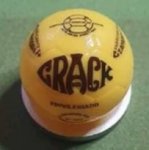
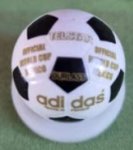
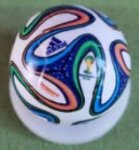
World Cup balls through the ages from Collecta balls.
The first new table soccer items I saw with decals were probably the small Subbuteo flags. I bought a couple of sets from Little Plastic Men in the early 2000s that were much better than the official ones done for the Premier League and Euro 96. You have to wonder whether collectors of the future will know which were official, and which ones weren't.
If flags are are obvious use of transfers, then balls were a natural next step. However, you would imagine that the curved surface brings its own problems. Step forward Terry Harman, who has a remarkable range called Collecta balls, which is currently available from The Wobbly Hobby Shop. Perhaps more for the display cabinet, than actually smacking around in play... They would look good on the ball pedestal I mentioned earlier.
Decals on painted players - Wobbly Hobby Shop Sides.

A good example of the modern fashion for teams enhanced by modern decals. These teams are at the top of the range, and with a price to match (not much change out of £100!). Although it should be pointed out that the modern precision playing bases will be making up about half of that cost. By this point, the decals are covering all the recognisable adornments to modern shirts/sleeves, and this team is showing how effective a base label can be.